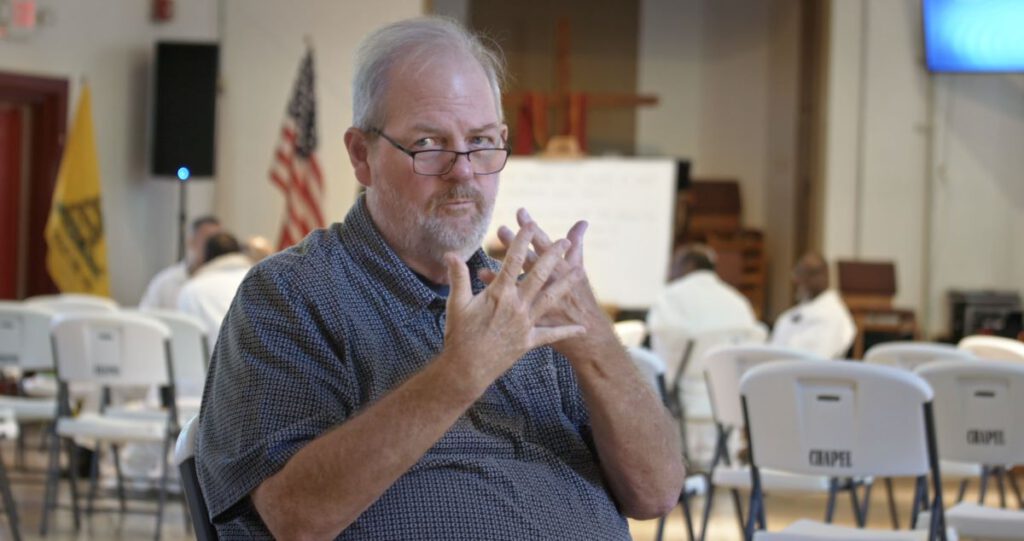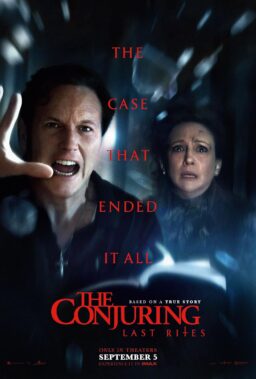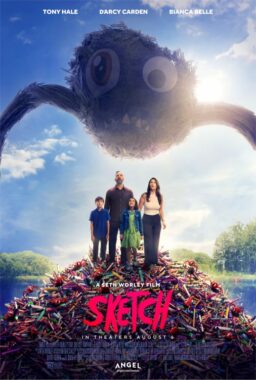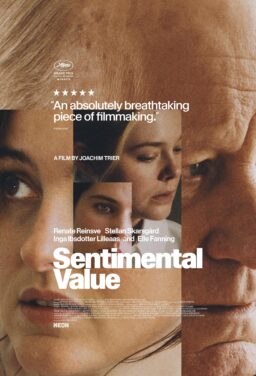The short documentary “Breaking Silence” focuses on the plight of the deaf community in prison and their lack of resources within the system. They don’t have enough translators or anyone in the facilities to help these inmates communicate or understand their needs. Lawyers often hesitate to take their cases. The prisoners often find themselves agreeing to things they wouldn’t normally agree to just so they can get through whatever process they need to get through. It’s a part of prison life that most people would never give much thought, but Amy Bench and Annie Silverstein’s documentary puts the spotlight on the subject via a father and daughter who have been through the experience and are doing something about it.
Walker Estes has been a deaf advocate for much of his adult life. He travels out to many prisons in the south and speaks to inmates about their frustrations about the system that too often fails them. Finally, these people have someone working on their behalf to make their days a bit more bearable, even if he’s just someone who can do nothing but listen. Sometimes that’s enough. Walker’s daughter, Leslie, a CODA (child of deaf adult) with a troubled past, has been through the prison system herself and is now out on parole. She has seen it all firsthand and now that she has grown older and wiser, works with her father to help deaf inmates, many of whom are trying to start their lives over now that they’re out. They need people like Walker and Leslie to make sure they have a smooth transition back into society and don’t fall into certain legal traps.
Bench and Silverstein have two stories to tell here: One, about Walker and Leslie’s advocacy and the second about their own past as father and daughter. They cover a lot of ground in seventeen minutes where the viewer gets a good sense of where each of these people came from and where they’re headed. The people they’re helping are some of the film’s warmest moments, but not in a way that feels treacly. We come to understand that the work they’re doing is not just out of advocacy or social justice, but also as a personal journey for both of them that feels like it still has a long way to go. I hope Bench and Silverstein catch up with them again.
Also worth noting is the choice to let the subtitled interviews of the deaf subjects run during long cutaways and sequences, without the aid of voiceover. It seems like such a simple, no-brainer idea, and yet I feel like this is the first time I’ve seen it done. The silence that’s left while we read their thoughts and ideas brings us closer to them, while also giving the film its own visual language that makes it all the more compelling.
This wasn’t planned, but January feels like the right time for this film. As we all start to look ahead at the new year and at things we’d like to change or make happen, “Breaking Silence” offers us a window into the lives of people who, in many different ways, face a new future with some help from others along the way. I hope there are more Walkers and Leslies out there.

How did you find this story?
The film originated with the idea of, “how can we tell a story about the impacts of incarceration on families, specifically women, in Texas?” As part of that research, Amy met Leslie via the nonprofit Truth Be Told at the end of 2019, just a few weeks after she was released from prison. We knew that her father was deaf, though we didn’t know how active he was in working with men who were currently and formerly incarcerated at that time. Walker was one of Leslie’s lifelines when she got out of prison, and they would talk daily on Facetime, because he lives a few hundred miles away in Baton Rouge.
As is the case with many documentaries, at the beginning of this project we had a different idea about the film we were making than what it became. As we got to know Leslie and Walker better, and came to understand how her time in prison inspired her father to advocate on behalf of deaf people impacted by the system, we shifted the central thread of the film to be a father-daughter story, that explores the ways in which their experience around incarceration has paved the way to healing- both together and through their work with others.
Are either of you fluent in sign language? If not, was that a challenge during filming?
We are not fluent in sign language. So once we realized during the filming process that Walker was becoming a central character in the film we had to pause and figure out an approach when filming in ASL. Some shoots we worked with our colleague from graduate school Leo Kinsler, who is an interpreter, who would Zoom or Facetime in during interviews, other times we used voice-to-text to communicate with Walker. We really left it up to Walker to decide when he was comfortable having an interpreter there, and there were times he preferred not to have an interpreter present. It is a small community and he personally knows many of the local interpreters, and he wanted to keep some privacy around some of the shoots. So we worked with Walker to figure out the approach that felt best, and of course Leslie helped at times when she was present.
Amy is a cinematographer and has experience filming in languages she’s not fluent in, where you lean into the body language. ASL is a very expressive language, so even if we didn’t catch specifics we knew the tenor of the conversation and would check in right after a scene.
In almost every movie or documentary I’ve seen involving a deaf person, there is often a voiceover gimmick or someone speaking the conversation to do the translating for the viewer. You went with subtitles, which is the most effective, especially when we don’t see Walker talking/signing. Was there a process of trying to figure out a way to use his interview segments before landing on using subtitles as voiceover?
During production, we spent a lot of time discussing voiceover and subtitle use. We decided that we wanted to try using captions instead of voiceover, as it felt more natural to our experience while interacting with Walker and Betha. We found beauty in the silence we as hearing filmmakers experienced. It was really when we presented a work-in-progress cut of the film to an intersectional audience of deaf, hearing, and formerly incarcerated individuals, that we knew that we had found a good approach. We got a lot of helpful feedback at these critique sessions. We were then able to work with our deaf consultants and editor to find a way to craft the interviews where we show Walker at the beginning of every statement he makes, and minimize cutaways, to make his perspective clear, as well as the other deaf characters in the film.

Amy, this is your first film in a long time that you directed or co-directed that wasn’t animated. What was that like for you? Likewise, Annie, what brought you back to making documentaries after focusing on narrative fiction?
Amy: I think one of the things that led me back to directing again, is having worked for a number of years as a verite cinematographer, which gives you really up-close up interactions with film protagonists, which I love, and I wanted to take that further. About six years ago I started making animation films as a way to do something different, to push the form of documentary a bit, and to have a hand in more creative aspects of filmmaking. In the kind of animated documentaries I have made, there is an opportunity to be more planned out in the storytelling before a large chunk of the production takes place, much like having a locked script in fiction, you can know the film beats, you can have a sense of the resolution.
We began production of “Breaking Silence” during the pandemic, during a time of great change and uncertainty, and our vision for the film kept evolving in response to what was going on in Leslie’s life and also in the world at that time. We were writing and re-writing the story beats while we were in production, sculpting the arc around the scenes we were able to capture. The timeline to complete stretched due to these constraints, but also led to exciting discoveries and a more nuanced film. Once we got access to the prison, which was 2 years in, the film started to land in a way that it hadn’t without those scenes. And we were able to weave the discoveries we made in making the film, into the discoveries the viewer makes while watching. I’d love to credit our editor Karen Skloss for working with Annie and me to beautifully structure and weave scenes and moments together to enable that unfolding of a relationship in a very natural way. Working with Annie, who is a terrific narrative director, was really wonderful in terms of her watching her apply her fiction writing skills to responding to unexpected documentary situations.
Annie: My background is in documentary, but about nine years ago I shifted to writing and directing fiction. I draw heavily from my experiences as a documentary filmmaker in my fiction work, so it never felt like a big divide – the forms have always informed each other in my mind. So transitioning back to documentary felt seamless in many ways. One thing, though, that I reveled in was just being able to set off with my two dear friends, Amy, and Monique, and shoot a scene, just the three of us. Getting back to the roots of how bare bones production can be… I loved returning to the documentary editing process and so enjoyed working with our wonderful editor Karen and Amy to weave the story together. And of course, getting to personally know Walker and Leslie. They showed such generosity and trust, bringing us into their home, sharing their life experiences, introducing us to their community, that part of the process is always deeply moving.
You chose to end the film with some hope, warmth and humor. Was it always obvious to you where the film would end or were there other versions that you tried in the editing?
We knew we wanted the end of the film to reflect where Walker and Leslie are at in their relationship to each other, as well as the work they are doing. Their relationship and work is still a “work in progress.” In many ways they used the opportunity this film provided to ask each other questions, and share things with each other that they hadn’t said before. The love between them was always there, but this process deepened their connection and understanding, and feelings of empathy and forgiveness. We found this so moving, and the end was not so much a conclusion, but a looking forward to the future. We followed their lead. Despite everything they’ve been through, they approach life with hope, warmth, and humor.
What’s next for you?
Amy: I am working on a new animated short and developing a feature about Walker, going deeper into the deaf advocacy that fuels his work and how his life experience– in addition to his relationship with Leslie– has led to this work.
Annie: Back to fiction for a spell. I wrote a feature script I’m hoping to direct next year. Monique is producing and we’re getting the ball rolling on that.












